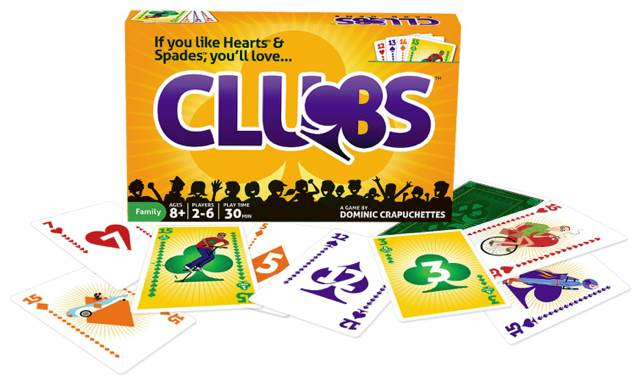
The Basics:
- For ages 8 and up
- For 2 to 6 players
- Variable game length
Geek Skills:
- Active Listening & Communication
- Counting & Math
- Logical & Critical Decision Making
- Pattern/Color Matching
- Strategy & Tactics
- Risk vs. Reward
- Hand/Resource Management
Learning Curve:
- Child – Easy
- Adult – Easy
Theme & Narrative:
- None
Endorsements:
- Gamer Geek mixed!
- Parent Geek approved!
- Child Geek approved!
Overview
My parents told me to never step on others to elevate myself or to steal for personal gain. Ironically, that is exactly what you must do in card games. Especially climbing games, where you must out play your opponents using their last play as your springboard. Stealing is also necessary, as taking cards from others is the only way to earn points. Charles Lamb once said, “cards are war, in disguise of a sport.” If that is true (and it is), get ready for a fight with clubs.
Clubs, designed by Dominic Crapuchettes and published by North Star Games, is comprised of 60 Play cards (in 4 different suits, 15 cards per suit) and 6 Bonus cards. All the cards are of excellent quality, but not overly durable. They were designed to be easy to shuffle and easy to deal. As such, they are somewhat thin, but flexible. They will crease easily, especially in the hands of a 4-year-old. I’m speaking from experience here. It’s like he was attempting to make a paper airplane or something out of the card. Horrible. Not included in the game, but necessary to play, is a pen or pencil and a piece of paper to keep track of the players’ scores.
Game Set Up
Note: Clubs comes with two different games. The standard game, simply referred to as “Clubs”, is discussed here. The second game, referred to as “Crazy Clubs”, is summarized under the “Game Variants” section of this review.
To set up the game, first shuffle the Play cards and deal 10 out to each player, face-down. Any Play cards left over are set aside. You will only use all 60 Play cards in a 6-player game. Players should look at their Play cards but keep them hidden from their opponents at all times. This is the player’s hand for the round.
Second, based on the number of players in the game, collect and set aside the following Bonus cards. Any Bonus cards not used are out for the duration of the game.
- 6-Player Game: use Bonus cards “12”, “10”, “8”, “5”, “2”, and “0”
- 5-Player Game: use Bonus cards “10”, “8”, “5”, “2”, and “0”
- 4-Player Game: use Bonus cards “8”, “5”, “2”, and “0”
- 3-Player Game: use Bonus cards “5”, “2”, and “0”
- 2-Player Game: use Bonus card “5” (see “Game Variants” section for further details)

That’s it for game set up. The player to the left of the dealer is the first player.
Let’s Go Clubbing
Clubs is played in rounds with no set number of rounds per game. During a single round, multiple hands will be played to the table. A typical hand is summarized here.
Step 1: Play Lead Meld
The first player of the round or the last player to take the previous trick will play the lead meld. Melds come in two different types.
Of-A-Kind: this meld-type is comprised of 1 to 4 Playing cards that share the same number value. For example, a “3 of-a-kind” meld-type could be 1 “Four”, 2 “Fives”, 3 “Nines”, or 4 “Tens”.
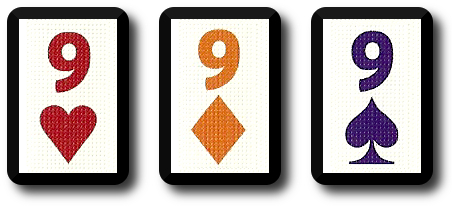
Runs: this meld-type is comprised of 2 or more Playing cards that have ascending sequential values. For example, “Nine and Ten” or “Three, Four, and Five”. The Play cards in the run do not have to share the same suit.
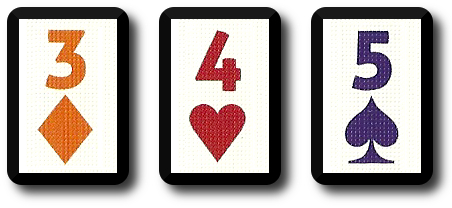
Step 2: Play to Meld
Now each player in turn order sequence will either play to the lead meld or pass. If the player passes, they are out for the duration of the hand. If they play to the lead meld, they must play the same meld-type, but at least one card in the meld must have a number value GREATER than the highest numbered Play card in the last played meld. For example, let’s take a quick look at a hand between 3 players were the “Of-A-Kind” meld-type was lead.
- Player One: Four Of-A-Kind, high card “Five”
- Player Two: Four Of-A-Kind, high card “Nine”
- Player Three: Pass
Game play now continues with Player One either playing a Four Of-A-Kind with a high card of “Ten” or higher or passing, which would result in Player Two winning the trick.
If the “Run” meld-type was lead, the hand might look something like the following:
- Player One: Run of 3, high card “Four”
- Player Two: Pass
- Player Three: Run of 3, high card “Five”
Game play now continues with Player One either playing a Run of “Six” or higher or passing, which would result in Player Three winning the trick.
Step 3: Winning the Trick
Players continue to take turns playing Play cards to the meld until one of two possible conditions occur.
- A player places a “15” which automatically wins the trick. The player collects all the Play cards played to the table for the current hand and places them face-up in front of them.
- All players but one pass. The player who did not pass collects all the Play cards played to the table for the current hand and places them face-up in front of them.
This concludes the hand and a new hand now begins.
Earning Bonus Cards
The Bonus cards are initially set to one side of the game playing area but are part of the game. The first player to place their last card during a round takes the Bonus card with the highest number value, the second player to place their last card during a round takes the next highest available Bonus card, and so on. The last player to have successfully or unsuccessfully placed their last card from their hand will collect the “0”Bonus card.
Ending the Round and Scoring
Once all the players or all but one player have placed their last card and all the Bonus cards have been claimed, players now count their points. Only the “Club” suit is counted. Each “Club” Play card has a point value on it. The lower the “Club” Play card number value, the higher the point value it awards. For example the “One of Clubs” awards the player 5 points and the “Fifteen of Clubs” awards the player 1 point. Once all the points from the “Club” suit Play cards are counted, the players then add to it the points awarded by their collected Bonus card. The total number is the player’s score for the round which is recorded or added to previously earned scores. A new round now begins by shuffling all the Play cards and dealing out 10 new Play cards per player. The Bonus cards are collected, as well, and set aside until claimed during the new round.
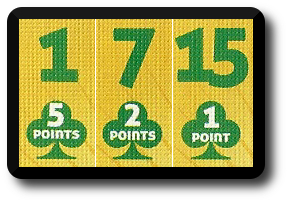
Double or Nothing
A player can optionally state “Double or Nothing” at the start of the round before the first lead meld is played. If they do so, they are attempting to be the first player out of the round. If they are successful, any points they earned during the round are doubled. If they fail, any points they earned, including the Bonus card, are not recorded.
Winning the Game
After each round, players count and record their score for the round, adding it to the total number of points scored from the previous rounds. The first player to score 50 or more points wins the game.
Game Variants
Clubs comes with a number of game variants that can be included to change the game play. They are summarized here.
Two-Player Game
Game play is the same, but only the “5” Bonus card is used. The round ends when the last trick is taken. The player to place their last card takes the Bonus card. Score all cards as normal.
15’s Are Wild
All the Play cards with a number value of “15” are wild and can be used to substitute any number value in a meld-type between the number values 1 through 15. Point values for the “Club” suit does not change.
Partner Play
Even numbered players play in teams. Points earned by team members at the end of a round are added together to provide a team score. The number of points a team must earn to win is dependent on the number of players and teams in the game.
Crazy Clubs
Game set up is the same, but there are slight variations on the game play. Tricks are only won after all players pass. The last player to place a Play card to the meld wins the trick. Play cards with a number value of “15” no longer win the trick by default. Additionally, a “15” can be beaten by any pair (for example, a pair of “10’s”). A pair of “15’s” can be beaten by any Three-Of-A-Kind and a run with a “15” can be beaten by any other run as long as it has one more card than the total number of Play cards in the run that included the “15”. In this way, players can play to the meld-type if one of the Play cards placed is GREATER than any of the last Play cards played or the number of Play cards placed must be GREATER than the number previously played Play cards.
To learn more about Clubs, visit the game’s web page.
Prediction
I believe Clubs will do very well with the Child and Parent Geeks. I also believe Clubs will be very well received by our non-gamers and more traditional card game players. This version of Clubs at first glance appears to be a streamlined version of the classic card games of the same name that I played as a little geek. Where the classic games of Clubs require its players to bid on how many tricks they’ll take, has a much higher number of points necessary to win the game, and a more complex method of counting points per hand, this version of Clubs has been stripped, greased, and streamlined resulting in much faster play and a lower bar of entry to learn the game.
And before you start sending me nasty comments, I do realize that “classic” suggests that there is one ruleset for the traditional card game of Clubs, but everyone knows this is not true. I have been taught many “classic” card games that use the standard deck of cards and there is always some slight variation in the rules. It all depends on which grandma, grandpa, aunt, uncle, or friend teaches you, I suppose. For example, I grew up with a very different version of Spades then my wife grew up with. I like her family version much better than mine, despite me not being able to ever win using the ruleset she provides. I swear, my wife has dark powers when it comes to playing card games…
Will the Gamer Geeks enjoy it? Hard to say. “Traditional” and “classic” sometimes doesn’t translate very well when it comes to the Gamer Geeks. The elitists are looking for games that introduce new concepts of strategy and tactics in a fresh and bold way. Clubs certainly doesn’t and might be less than well received as a result. However, Clubs does appear to be a very solid game and most Gamer Geeks have not forgotten their humble roots, so to speak. As such, it might do well on a Gamer Geek’s table due to the slight nostalgic factor the game provides and its quick game play.
Teaching Clubs is a very easy exercise. You will find that players who are familiar with card games tend to be a bit confused when you tell them suit and color do not matter when it comes to creating Run meld-types. Hardly a difficult mental barrier to jump, but I was always asked to repeat this simple rule several times when I was teaching the game. You shouldn’t expect problems teaching Clubs to non-gamers or younger Child Geeks, either. All that is necessary is simple number and pattern recognition.
And so, after teaching Clubs to my two oldest little geeks, I asked them their thoughts on the game so far.
“I think I’ve played this game before at the cabin. Looks easy enough, but I don’t know how long it’ll be interesting to me.” ~ Liam (age 9)
“But Dad, I’ve already done my homework! I don’t want to do anymore math!” ~ Nyhus (age 6)
Both of my little geeks have played a game like Clubs before, but not this specific game. I’m pleased to see that my oldest is starting to remember past games and their game mechanisms. That’ll make it much easier for him to learn new games. Not happy to hear he is judging the game based on appearance alone. As for my 6-year-old, homework is never done as you never stop learning. Let’s play Clubs and see what we learn.
Final Word
The Child Geeks were not sure how to feel about the game at first. When I taught them Clubs, they certainly grasped the rules and the game’s intent quickly, but their card plays suggested they really didn’t know what they were doing. In truth, they were simply reacting to what was being played in front of them instead of thinking about the game and their hand in the long-term. Clubs is, more than anything, about hand management. The younger little geeks didn’t demonstrate a solid enough grasp to lead me to believe they were understanding that aspect of the game. The older Child Geeks did. As a result, the older Child Geeks won all the games against their younger peers. Frustrating for the younger Child Geeks, to be sure, but no one complained about the game. Most of the complaints focused on other players and their card choices. When the games were done, the majority of Child Geeks thought the game was “OK” and “nothing special”. They enjoyed it enough to approve the game, but I doubt any of them would be requesting Clubs be played in the near future. There were a number of older Child Geeks who loved it and eagerly played hand after hand after hand with their Parent Geeks.
The Parent Geeks, especially the more casual card game players and non-gamers, really enjoyed Clubs. They found the game play to be intuitive, the speed of the game to be well paced, and the level of difficulty enough to keep them engaged without the need to be fully focused. I introduced the Crazy Clubs game variant, but the majority of Parent Geeks prefered the standard game play. Playing all “15’s” as wild went over fairly well. One Parent Geek said, “I like playing simple card games that don’t have a lot of flash, but do have a lot of excitement. I love this.” Another Parent Geek said, “The rules are simple and the game play is fun. I’d play this again.” All the Parent Geeks approved the game and found Clubs to be a good time with both their family and their peers.
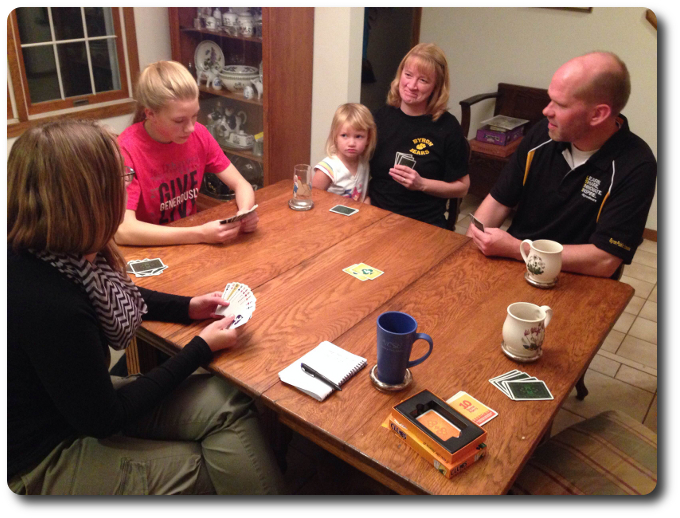
Coffee, Clubs, and Company: a great way to spend an evening with friends
It was difficult getting Clubs in front of our Gamer Geeks. The majority of the gaming elitists saw Clubs as a simple card game, which immediately had them disinterested. When I was able to sneak in a game or two, either before larger games or during lunch breaks, the Gamer Geeks either really enjoyed it or found the game to be completely forgettable. According to one Gamer Geek who enjoyed the game, “The basic game is OK, but does improve a great deal when you play it with the Crazy Clubs game variant. I’d play this again, but only if there was nothing else to play.” Another Gamer Geek who did not care for Clubs said, “This is a good enough game, but I find it too simple and way too light. I want my games to have more depth and more meaning than simple card plays.” In the end, the Gamer Geeks were mixed with the more casual Gamer Geeks enjoying Clubs and the more hardcore Gamer Geeks rejecting it.
Clubs has a good mix of trick-taking and climbing, which should appeal to most traditional card game players. It’s also a very easy card game to teach. I think it’s a great game to put in front of casual players, non-gamers, and inexperienced gamers. The Crazy Clubs game variant brings it closer to what a Gamer Geek likes in a good card game, but Clubs always feels like a gateway game to me. It introduces some fun game play, but never takes it further than a few steps past the introduction. This makes the game very easy to learn and to play, but any player looking for a game of great depth will not find it here. The game is solid, well-balanced, and lively, but I don’t see it ever being more than an introductory game. Individuals will learn how to play it, love it, and then move on to a new game that is more complex.
Would I recommend Clubs? Only to Child Geeks, Parent Geeks, and non-gamers. I don’t think there is much to Clubs to suggest that it’s a Gamer Geek game. I just don’t see Clubs ever making its way to the gaming table at a Gamer Geek gathering. There are more complex and interesting card games available to the elitists and they know it. Clubs will be the first game I bring, however, when I know I’m going to be at a party with parents and children who enjoy a good card game and a good time.
This game was given to Father Geek as a review copy. Father Geek was not paid, bribed, wined, dined, or threatened in vain hopes of influencing this review. Such is the statuesque and legendary integrity of Father Geek.




Pingback: Galipotes Game Review » Father Geek